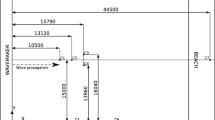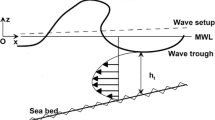Abstract
The longitudinal dispersion of contaminants due to mass transport induced by random surface waves is examined. The wave kinematics under random waves are first derived, including the second-order drift profile. The relationship between the dispersive coefficient and wave drift is then established following the approach in J. Hydraul. Res. (2000) 38:41–48. Subsequently, the magnitude of the longitudinal dispersive coefficient is examined under both developed and developing sea states, represented by the P–M spectrum and the Wen spectrum, respectively. The results show that the longitudinal dispersion by random waves is significantly stronger than an equivalent regular sea state with a similar wave energy density. Furthermore, the dispersive effect in the developing sea state is found to be stronger than the developed sea state with comparable wave-energy density, which can be attributed to the differences in the spectral shape between the two states.
Similar content being viewed by others
References
Taylor GI (1953) Dispersion of soluble matter in solvent flowing slowly through a tube. Proc R Soc Lond A 219: 186–203
Fischer HB, List EJ, Koh RCY, Imberger J, Brooks NH (1979) Mixing of inland and coastal waters. Academic Press, New York
Smith R (1982) Contaminant dispersion in oscillatory flows. J Fluid Mech 114: 379–398
Van Den Broeck C (1990) Taylor dispersion revisited. Physica A 168: 677–696
Watson EJ (1983) Diffusion in oscillatory pipe flow. J Fluid Mech 133: 233–244
Yasuda H (1984) Longitudinal dispersion of matter due to the shear effect of steady and oscillatory currents. J Fluid Mech 148: 383–403
Law AWK (2000) Taylor dispersion of contaminants due to surface waves. J Hydraul Res 38: 41–48
Longuet-Higgins MS (1953) Mass transport in water waves. Philos Trans R Soc Lond A 245: 535–583
Unluata U, Mei CC (1970) Mass transport in water waves. J Geophys Res 75: 7611–7618
Craik ADD (1982) The drift velocity of water waves. J Fluid Mech 116: 187–205
Monismith S, Fong DA (2004) A note on the potential transport of scalars and organisms by surface waves. Limnol Oceanogr 49(4): 1214–1217
Fredsoe J, Deigaard R (1992) Mechanics of coastal sediment transport. World Scientific Publishing, Singapore
Huang G (2009) Advection and dispersion of pollutants and small rigid objects under regular and random waves. PhD thesis, Nanyang Technological University, Singapore
Goda Y (2010) Random seas and design of maritime structures. World Scientific Publishing, Singapore
Eckart C (1952) The propagation of gravity waves from deep to shallow water. Nat’l Bur of Stds, Circular 521, Washington, DC, pp 165–173
Bretschneider CL (1959) Wave variability and wave spectra for wind-generated gravity waves. Beach Erosion Board, US Army Corps of Engineers, Technical Memorandum, No. 118
Mitsuyasu H (1980) Observation of the power spectrum of ocean waves using a cloverleaf buoy. J Phys Oceanogr 10(2): 286–296
Scott JR (1965) A sea spectrum for model tests and long-term ship prediction. J Ship Res 9(13): 145–152
Pierson WJ, Moscowitz L (1964) A proposed spectral form for fully developed wind seas based on the similarity theory of S.A. Kitaigorodskii. J Geophys Res 69(24): 5181–5190
Yu YX (2000) Random wave and its applications for engineering. Dalian University of Technology Press, China (in Chinese)
Hasselmann K et al (1973) Measurements of wind wave growth and swell decay during the Joint North Sea Wave Project (JONSWAP). Deutsches Hydrograph Inst 12(A8): 1–95
Huang NE, Long SR, Tung CC, Yuen Y, Bliven LF (1981) A unified two-parameter wave spectral model for a general sea state. J Fluid Mech 112: 203–224
Wen SC, Zhang DC, Guo P, Chen B (1994) Form of deep-water wind-wave frequency spectrum (I): derivation of spectrum. Prog Nat Sci 4: 407–427
Wen SC, Guan CL, Sun SC, Wu KJ, Zhang DC (1996) Effect of water depth on wind-wave frequency spectrum (I): spectral form. Chin J Oceanol Limnol 14(2): 97–105
Author information
Authors and Affiliations
Corresponding author
Rights and permissions
About this article
Cite this article
Huang, G., Law, A.WK. Taylor dispersion of contaminants by random waves. J Eng Math 70, 389–397 (2011). https://doi.org/10.1007/s10665-010-9432-6
Received:
Accepted:
Published:
Issue Date:
DOI: https://doi.org/10.1007/s10665-010-9432-6




